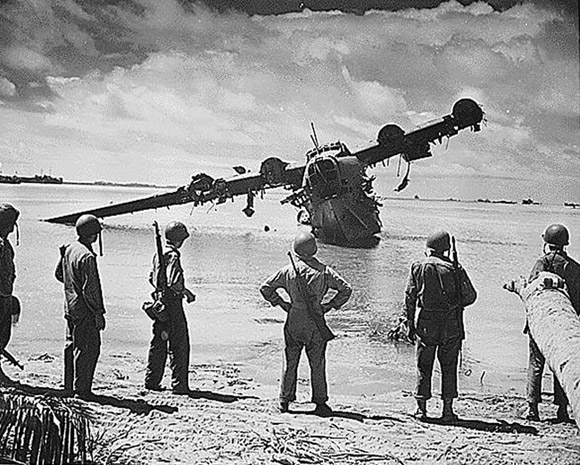The Second Pearl Harbor Attack

This U.S. Army archive photo shows a Japanese H8K seaplane shot down over Kwajalein Atoll — the same type of plane used in the March 1942 attack on Pearl Harbor
“That’s the second Japanese attack on Pearl Harbor,” he said.
A second attack on Pearl Harbor? Holy moly, why hadn’t I ever heard of that?
But it’s true, and luckily not much came of it except for some dampening of morale in the Navy because we never intercepted those Japanese attackers, either.
It was in the early morning darkness of March 4, 1942, almost three months after the devastating Dec. 7 strike.
The Japanese had built huge H8K amphibious aircraft capable of carrying four 550-pound bombs. They were long-range planes, but would be stressed to make it from their Marshall Islands launch field to Hawaii and back without refueling. Somebody came up with the idea of a refueling submarine waiting off French Frigate Shoals.
The plan was to disrupt our salvage and repair operations in the aftermath of the Dec. 7 attack. If this one worked, Tokyo planned to keep harassing Pearl Harbor. They’d regularly sneak in during darkness.
Two planes were loaded for the raid, took off and refueled at sea as planned.
But here’s the first oddity. We’d already broken the Japanese wartime code, so had a pretty good idea what was up. Still, everyone in our chain of command seems to have ignored it until the planes were on our radars.
We did send up some interceptors, but night aerial combat was in its infancy, and because of cloudy weather our fliers never spotted anything.
Things weren’t going much better for the Japanese pilots. A submarine sent out to Hawaii to radio directions and report if the weather was OK apparently was lost at sea. So the sea-plane pilots were flying blind. We had a strict blackout in effect, so they couldn’t see squat from their cockpits.
One pilot dropped his bombs about 300 yards mauka of Roosevelt High School in the Tantalus woods. The other got close to Pearl Harbor, but his bombs fell harmlessly in the ocean. Both pilots returned to their Marshall Islands base.
It’s a good thing the raid was a failure because that was the last one, and the Japanese scrapped the idea of similar bombing raids on the West Coast.
They did try just a Pearl Harbor reconnaissance flight by one of the earlier pilots, but a short time after takeoff he was shot down by patrolling American planes near Midway.
A book about this whole affair says the raid did affect U.S. Navy morale. Adm. Chester Nimitz’s chief of intelligence, Capt. Edwin T. Layton, suggested one of the Army’s planners, Wilfrid J. Holmes, let the raid happen to embarrass the Navy. Holmes was exonerated by a full, embarrassing investigation.



